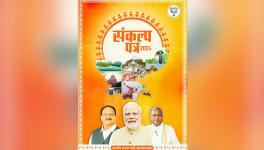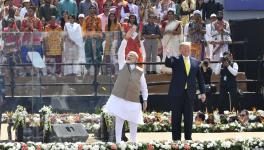Why the Central Vista Redesign Project is on Shaky Ground Itself
A Fascist leader wants to leave an imprint of his glory; a footprint that does not just limit itself to the polity, but extends across a wider spectrum that includes art and architecture. If the construction of Volkshalle was Hitler’s idea, it was designed and planned by Albert Speer. Similarly, the proposal for the construction of a new parliament building along with the redevelopment of the Central Vista in Delhi by Prime Minister Narendra Modi and his prime architect, Bimal Patel, is another parallel to a similar idea.
If the country is fighting a pandemic and there is dire need for resources to be spent on basic equipment including medicines, tests and kits, then, it is the duty of the government to divert resources for such equipment. Instead, the Government of India is more interested in building new castles and is hell bent on diverting public money for the construction of such buildings. A sum of Rs 20,000 crore will be spent on the redevelopment of the central vista in Delhi. Architects differ on how much this exercise would cost, and state that the government will actually land up on spending nearly Rs 30,000 crore for the project.
Many architects refer to such a parallel (between Hitler-Speer and Modi-Patel) as hyped opinion and term the present proposal as the baggage carried by Modi, babus in the secretariat, and Bimal Patel. However, presentations made by Bimal Patel in different parts of the country clearly mentioned the reason for a change in the design of the new parliament – from round to triangular, aside from the more explicit reasoning of a requirement of space to accommodate more MPs and sarkari babus. Patel said the design of the new parliament is in sync with the Sri Yantra of Hindu mythology; the triangle represents the Trimurtiof Brahma, Vishnu and Shiva. In fact, this is part of a larger hegemonic Hindutva project, where religious symbols are the premise for the design.
WHAT IS GOING TO HAPPEN IN THE CENTRAL VISTA
The central vista precinct extends from the Rashtrapati Bhavan to India Gate. It includes the North Block, South Block, the Parliament building, and the central government secretariat buildings along Rajpath and all the way up to the India Gate circle, and all the plots of land immediately around it. According to the proposal, which does not have a detailed project report (DPR), a redevelopment of the central vista is intended to take place, which shall include construction of the new parliament building at the intersection of the triangle of the Red Cross Road and the Raisina Road. The plan includes the demolition of a few existing secretariat buildings like Shastri Bhavan and Rail Bhavan etc, as well as the National Museum, the Ministry of External Affairs’ building, Vice-President’s residence and all other buildings along Rajpath with the now sole exception of the National Archives.
The old buildings like the North Block and South Block shall be used as spaces for museums. A new office for the Prime Minister and his mansion residence adjoining the South Block will be constructed. The PM’s house shall be connected to his new office and to the new parliament through an underground tunnel. It is said this space will be nuclear-attack resistant.
Interestingly the details are only sketchy, obtained from presentations made by the architect Bimal Patel in various parts of the country and according to him, this is an always evolving project. No exhibition of the drawings have been made to the parliament or to the public, given that nearly 25,00,000 square metres of construction will take place.
REASONS PROFESSED BY THE GOVERNMENT FOR SUCH A PROJECT
One of the primary reasons for the move, which the government does not pronounce openly, but is fully convinced by, is that the parliament building is cursed and that, as a result, successive prime ministers and other leaders did not live for longer.Hence, a new building, one that is triangular in shape instead of circular, must be built. The idea was floated by one Ashwinie Kumar Bansal, a vastu expert, who had been summoned by Manohar Joshi, the then speaker of the Lok Sabha, in the year 2002. According to Kapil Komireddi’s piece, titled ‘Modi’s ghastly Delhi dream’, Bansal surveyed the parliament house and recommended remedies to “rescue India”.
“It is the circular building, he declared in a confidential memo to the speaker, which ails the nation’s polity. To Bansal, it was an odd piece of architecture made according to the whims and fancies of a foreigner. It evinced no fidelity to Hindu, Islamic, or Christian conventions of construction. And its round shape, evocative of a zero and epitomising void and nothingness, endowed it with a mystical power to destroy anything that interacts with it.”
There are other reasons for the redevelopment of the central vista which are sugar-coated and presented before the people. A major one is that the space to accommodate the prospective increase in number of MPs (after the de-limitation) and the secretariat staff will be less, hence a large space is required. It was also stated that the old buildings are not seismic proof and hence the country cannot take the risk of its leaders dying under the rubble in case an earthquake strikes us.
CORE ISSUES WRONG WITH THE PROPOSED CENTRAL VISTA REDEVELOPMENT PROJECT
Let us examine these issues one by one. The foremost argument linking it to obscurantism has no valid basis and cannot be countered on any rationale. However, that the architecture of the parliament and the buildings are not in sync with the Indian ethos is not true. In fact, before the construction of the central vista began,there was an interesting debate between prominent architecths Herbert Baker and Edwin Lutyens. According to Swapna Liddle, a historian, the British had left behind English architecture in Calcutta and Simla, before shifting their winter capital to Delhi. She explains the reason for it. According to her, the British wanted to build something in sync with the Indian ethos. Why? “Because the British wanted to continue their rule, and as a manifestation to the rising Indian freedom movement, they wanted to exhibit that what they are constructing is not alien to Indianness! Hence, they had recognised that the structures of their new capital would have to be constructed in sync with the Indian ethos. Therefore there are domes, chhattris, jharokhas and red sand stones used.”
Quoting E.B. Havell, the then British art planner, she likened thecentralvistato the sulah e kul of Akbar. She mentioned that it was the syncretic ethos in which the Central Vista and the three important buildings were designed. The British moved to the parliament building in the year 1930 and ruled the country for 17 years, whereas our own elected governments have ruled the nation for 70 years. Hence, it is a misnomer to say that the CV and the buildings are colonial vestiges and we must get rid of them. Above all, even during the British Raj, these buildings were constructed from the sweat and toil of Indian people, hence being very much Indian.
The second reason cited for the construction of the project is that the increase in number of MPs after the delimitation exercise would be higher and that the present chambers cannot accommodate them. This is but another faulty statement. Presently, the space occupied by the parliamentarians is almost 1.5 times more than the per capita availability of space in the British Parliament. The architects opposing the CV have cited various seating plans even to accommodate a larger number of MPs within the existing parliament building.
The argument mooted by the government that the present buildings are unsafe for the MPs does not hold much ground. Till date no study has been done to measure the seismic vulnerability of the three important buildings. Even going by the government’s argument; that the North Block, South Block and the parliament buildings are unsafe, do they not realise that after shifting the secretariat staff and the MPs, there will still be people who will be working in these buildings? Dotheir lives not matter much to the government? Instead, what is required is a proper assessment of the building and reinforcements, if required.
OTHER MAJOR ISSUES
The proposal of redevelopment of the CV sounds like a big scandal in the offing. There is no DPR, which could have been contested by different parties. Further, the process is very opaque. There is hardly any representation of the people. The proposal has shown a complete disregard to environmental laws. There is also the violation of the basic land laws and the project is in contradiction with the Delhi master plan of 1961 and 2021.
There was no sharing of the proposals received to revamp the Central Vista. Since there isno DPR for the project that informed participating architects about the original brief, instead, every architect gave very diverse proposals: one among which was selected in what seems a near-random exercise. No preceding studies of exact requirements of government office space were provided or tabled. It means that the project is always evolving, as stated by the architect who is executing the CV project.
There has been no cost analysis either. The manner of awarding the contract is also opaque. The principle followed is QCBS-quality and cost-based selection. This method is used for the procurement of goods and cannot be applied for a project. In a project, comparative designs must be first analysed after seeking them out though a large open public competition administered fairly and transparently and with an eminent jury, as done for other buildings in the past in this very precinct. None of this is true in this case.
Another major flaw is the violation of the master plan of the Delhi city. The land use in the 1961 and 2021 master plan terms these spaces as: to be used largely for socio- cultural purposes, thus public buildings. Other parts being built open were preserved as open green spaces. The proposal for the new parliament construction is a ‘designated district park’. The land use for the park cannot be changed. Even for a change of land use for other spaces, there is a procedure which must be adopted. The haste with which the government tried to hush up the matter has landed them in litigation.
The trick that the government played is that instead of proposing the CV project as one project, they are pursuing it in parts. For example,environment clearance is only being sought for the parliament building, though it constitutes the same composite project. One of the reasons to do so is that it underplays the cumulative impact on the environment. The approach is incorrect; no preliminary studies have been carried out or tabled in the public domain on the environment impact, heritage assessment or transport studies.
One of the most important violations is the usurping of the urban commons. These are spaces which the common people use for various activities.
The government must realise that it is just the custodian of the property which is owned by the people as is magnificently described by the Constitution of India. The custodian has no right to infringe on the spaces of the common people which otherwise shall be detrimental to the overall health of the society and the polity.
The author is former Deputy Mayor of Shimla. The views are personal.
Get the latest reports & analysis with people's perspective on Protests, movements & deep analytical videos, discussions of the current affairs in your Telegram app. Subscribe to NewsClick's Telegram channel & get Real-Time updates on stories, as they get published on our website.
























